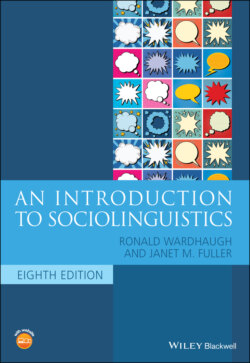Читать книгу An Introduction to Sociolinguistics - Ronald Wardhaugh, Janet M. Fuller - Страница 58
Development of AAVE
ОглавлениеSociolinguists have disagreed on how AAVE relates to other varieties of English in the United States. Kurath (1949, 6) and McDavid (1965, 258) argued that AAVE had no characteristics that were not found in other varieties of English, particularly nonstandardized varieties spoken by Americans of any color in the south. This is sometimes called the Anglicist hypothesis of origin. In this view, AAVE is just another dialect of American English (see Wolfram and Schilling‐Estes 2005 for more discussion).
Wolfram (2003) and Wolfram and Thomas (2002) take a slightly different position, favoring a neo‐Anglicist hypothesis that early African Americans maintained certain features of the languages they brought with them while at the same time accommodating to the local dialects of English. Wolfram and Thomas say that such a substrate influence (see chapter 9) from the African languages still persists in AAVE, certainly in the variety they examined in Hyde County, North Carolina. Wolfram and Torbert (2006, 228) claim that ‘AAE has diverged from European American varieties over the years, so that present‐day AAE is now quite different from contemporary benchmark European American dialects. The differences are not due to earlier language history, but to the everyday nature of African American speech during the twentieth century.’
Diametrically opposed to this view is the view of the creolists, for example, Stewart (1967), Dillard (1972), and Rickford (1977, 1997, 1999), who maintain that AAVE is of creole origin, and therefore a variety of English which originated quite independently of Standard English. (As we’ll discuss in more detail in chapter 9, creole languages are languages which develop in situations of language contact; in this case, contact between English‐speaking settlers and colonizers and speakers of West African languages who were brought to the Americas as slave.) In this view, AAVE has features that are typical of creole languages, particularly the zero copula and habitual be, some residual Africanisms, and certain styles of speaking (such as rapping, sounding, signifying, and fancy talk) which look back to an African origin. The claim is that AAVE is not a dialect of English but a creolized variety of English which continues to have profound differences from the standardized variety.
However, more recent research seeks to incorporate both of these views, noting that while settler varieties may have formed the basis for AAVE, there is also evidence of the influence from creole varieties such as Gullah and possibly Caribbean creole languages (Winford 2017). Mufwene (2014) also promotes a view which combines these influences, taking the position that the English‐origins position prevails, but this does not rule out contributions from creoles and African languages on the development of AAVE.
